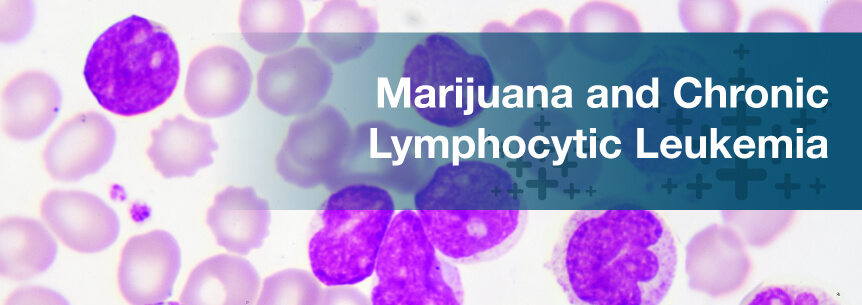
Medical marijuana has been a “go-to” for many cancer patients to help them find relief from their cancer symptoms, such as the pain, nausea and lack of appetite associated with chemo treatments. Now, however, cannabis — including medical marijuana for leukemia — is beginning to gain recognition for being able to fight cancer itself and help soothe the symptoms of its treatments.
Marijuana has long been used as a treatment for cancer. In fact, in one archeological investigation, the herb was identified on a Siberian woman whose body was 2,500 years old. Researchers further investigated and devised the theory that she had been treating her symptoms of breast cancer with cannabis. These days, patients with cancer are still turning to marijuana — including using the powerful herb to help with leukemia.
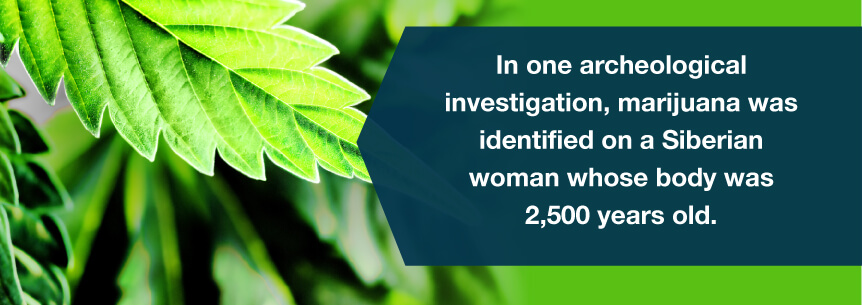
Medical cannabis for chronic lymphocytic leukemia represents a solution many patients turn to for relief of nausea and pain related to their chemo treatments. But, lately, there’s been evidence to show that the herb fights cancer itself, including leukemia.
Find A Doctor Find A Dispensary
The widespread cannabis medical properties trace to your endocannabinoid system. This is the natural cannabinoid system of your body. It involves the regulation of the human body’s various basic functions, such as:
The endocannabinoid system, along with maintaining your basic functions, may also respond to illness. It holds promise in treating a variety of conditions and diseases in addition to its extensive effects on your body. Scientists have been experimenting with different ways to target this system.
Through medical cannabis, researchers can target the endocannabinoid system for treating certain medical conditions. CBD and THC marijuana compounds interact with your endocannabinoid system to produce therapeutic effects.
A May 2017 published study showed that CBD and THC killed leukemia cells successfully on their own. But, according to the findings, the cannabinoids work better after a patient uses chemo and not before.
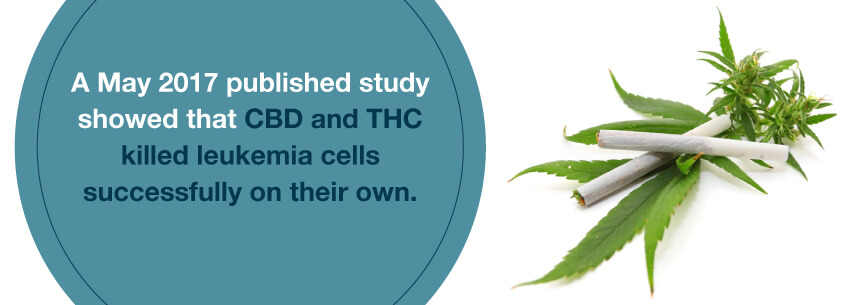
A U.K. scientist found the marijuana compounds kill cancer cells in leukemia patients. In fact, according to Dr. Wai Liu, author of the study, there’s a complex action to cannabinoids, which allows them to target certain essential processes cancer requires to survive.
Researchers looked at six various non-psychoactive cannabinoids and published their findings in a study in the Anticancer Research International Journal of Cancer Research and Treatment. These compounds came from cannabis but didn’t cause the same “high” that THC does. They showed a display of therapeutic qualities which all targeted pathways enabling cancer to grow and switched them off.
Marijuana for chronic lymphocytic leukemia can help with a variety of symptoms including:
Additionally, CBD was found to help with preventing any complications as a result of bone marrow or stem cell transplants in leukemia patients.
It’s not surprising to see marijuana and chronic lymphocytic leukemia treatment in patients can help with numerous symptoms like aiding sleep, offering energy, promoting weight gain, boosting your appetite and enhancing your social life.
At present, one of the most accepted and widespread uses of medical weed for treating cancer is known as “antiemetic.” Chemo treatments can bring on a lot of intense nausea and vomiting as well as pain, and cannabis can help to curb this.
Below are some popular strains to treat your cancer symptoms.
You may go through some trial and error when choosing the best medical cannabis strain for your leukemia symptoms. Each strain will require its own dosage and you need to factor in individual tolerance. Once you find a medical marijuana dispensary for your treatment, they’ll be able to recommend the best dosage and strain to help alleviate your symptoms.
Once you’ve obtained your marijuana card and recommendation from your doctor, you can then buy various types of medical marijuana from your marijuana dispensary. While smoking cannabis is popular, there are other methods you may benefit from, including:
According to anecdotal reports from medical cannabis patients, cannabis oil is a go-to method to take marijuana for chronic lymphocytic leukemia.
If you reside in a state where cannabis is legal, you first need to get a valid authorization or recommendation from a doctor. You can search for a medical marijuana dispensary or locate a doctor on MarijuanaDoctors.com.
Once you get your recommendation and card, you can begin searching for your cannabis and chronic lymphocytic leukemia treatment to help with your symptoms and find the relief you deserve.
Find A Doctor Find A Dispensary
Chronic lymphocytic leukemia (CLL) is a type of cancer that affects your bone marrow and blood. The marrow of your bones produces blood cells within. When the DNA in your blood-producing cells has genetic mutations, it can cause CLL. There isn’t any conclusive reason for these abnormalities. While you inherit most genetic changes before you’re born, these DNA genetic alterations come on throughout your life.
With CLL, your bone marrow is producing too many white blood cells (lymphocytes), which don’t function properly. This causes more issues, since they hinder the proper production of other blood cells.
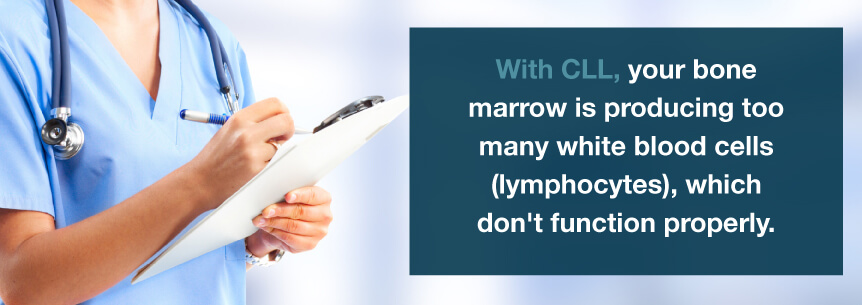
There are two classifications for CLL. They are indolent (slow-growing) or aggressive (fast-growing):
CLL’s history started officially in 1845, but some might say its debut was actually in 1749, when Joseph Lieutaud noted “the globuli albicantes,” or first white cells. Many events have helped doctors understand chronic lymphocytic leukemia etiology and treatment in the intervening years.
Overall, CLL patient survival has seen an improvement over the last few years thanks to more modern treatments.

Depending on the extent and stage of your CLL, symptoms may vary. Early on, you might not have any symptoms, but as your CLL progresses, you may experience symptoms such as:
If you notice any of the symptoms above, contact your doctor. Your outlook is much better the sooner you get a diagnosis.
People who have chronic lymphocytic leukemia are at an increased risk for developing more frequent infections, having immune system issues and getting other types of cancers, such as of the lung, skin and digestive tract.
Some CLL transformations or complications can occur without any triggering cause. You may experience blood cell-related effects such as:
All of these indicate a reduction in certain blood component levels.
How your physical health changes depends on various factors, including the stage of your leukemia, dose and length of treatment and overall health. You may experience physical side effects even after you’ve stopped treatment.
You have about a 30 percent chance from your time of diagnosis of struggling with debilitating depression or anxiety. Although there’s a 70 percent likelihood your depression or anxiety won’t be overwhelmingly distressing or debilitating, it will still impact your joy, family, work, life and personal relationships.
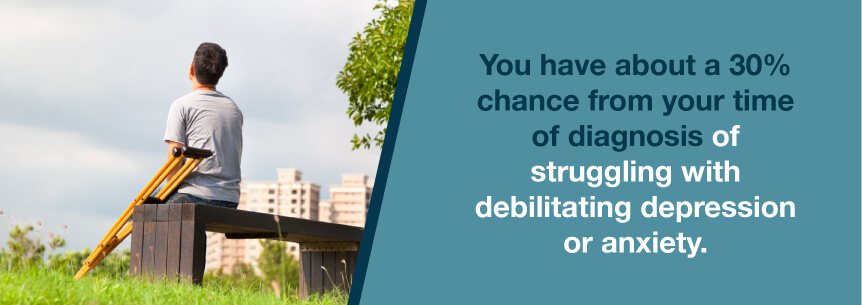
With CLL, you’re dealing with a “watch-and-wait approach” or treatment journey, depending on the stage and severity. This can make your depressed mood or anxiousness waver. And, whether you’re in treatment or a holding pattern, your level of depression or anxiety won’t be any different. However, according to the evidence, you’ll experience more anxiety during the watch-and-wait period and more depression during treatment.
Estimates for 2017 by the American Cancer Society for leukemia in the U.S. show:
In two-thirds of CLL patients, the disease progresses slowly or stays stable for many years. These individuals may be able to stave off treatment for several years — and some may never need treatment. For the other one-third of chronic lymphocytic leukemia, cancer progresses rapidly with debilitating symptoms. Prompt treatment is essential in this latter group to slow the disease progression and prolong life.
Men are twice as likely as women to develop CLL. The Leukemia & Lymphoma society reports chronic lymphocytic leukemia is the most common type of adult leukemia. Evidence suggests there could be an association between CLL and using certain herbicides, such as Agent Orange, which was used during the 10-year period of 1961 to 1971 and during the Vietnam era.
Several factors determine your CLL treatment options, including if you’re experiencing symptoms, the stage of your CLL, your preferences and your overall health. When you’re in your earlier stages of the disease, you usually won’t require treatment.
Your physician uses your test results, the stage of your CLL and your health overall to decide on an appropriate treatment. If they feel you’re in an intermediate or advanced stage or your disease is progressing, they’ll begin exploring the following treatment options.
Chemo is a type of medication treatment to kill growing cancer cells quickly — and, unfortunately, your healthy cells, too. Your oncologist administers chemo through either pill or intravenous form. They may use a combination of drugs or a single chemo drug depending on your circumstances.
Side effects of chemo include:
These drugs are used to target the particular vulnerabilities of cancerous cells. Your oncologist tests your cancer cells to decide which targeted drugs will help the most. While scientists believe targeted drug therapy is less toxic than the drugs used in chemo, they may have side effects, regardless.
Common side effects of this type of therapy are liver problems and diarrhea. Other side effects may include:
Also referred to as a stem cell transplant, this procedure kills your bone marrow’s stem cells that produce diseased lymphocytes using potent chemo drugs. After this, the doctor infuses a donor’s healthy blood stem cells into your blood, where they begin traveling to your bone marrow and start to make healthy blood cells.
Side effects of bone marrow transplant may include a headache, drop in blood pressure, chills, fever, pain, fatigue, risk of infection, nausea or shortness of breath. Long-term side effects include thyroid issues, lung damage, infertility, cataracts, early menopause in women, bone destruction and the risk of developing another type of cancer.
With this treatment, immunotherapy uses your body’s immune system to fight cancer. This procedure strives to use your immune system to locate and fight cancer cells. Side effects may include dizziness, vomiting, body aches, weakness, chills, fatigue, fever or nausea.
If you have pain from a swollen lymph node or swelling in your spleen, your oncologist may advise radiation therapy to shrink these issues. Fatigue and skin issues, such as blistering, peeling and redness are potential side effects of radiation.
In some cases, your surgeon may remove an enlarged spleen through a procedure known as a splenectomy. Surgery has a host of side effects, including infection and risk of death.